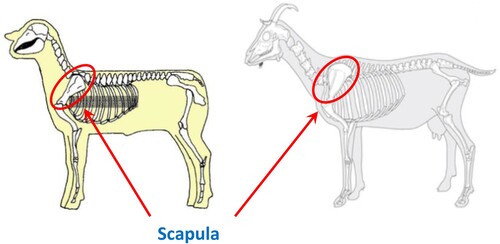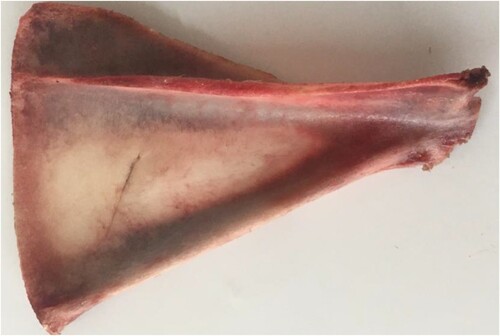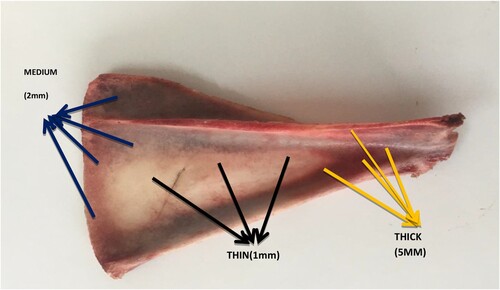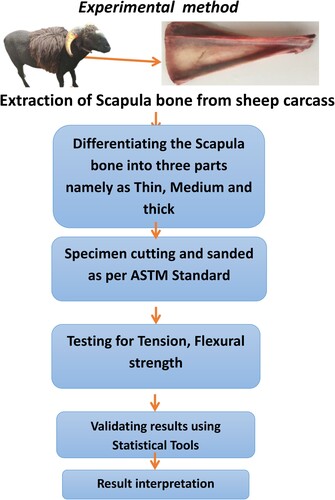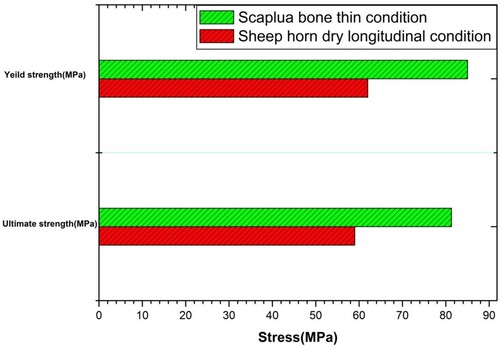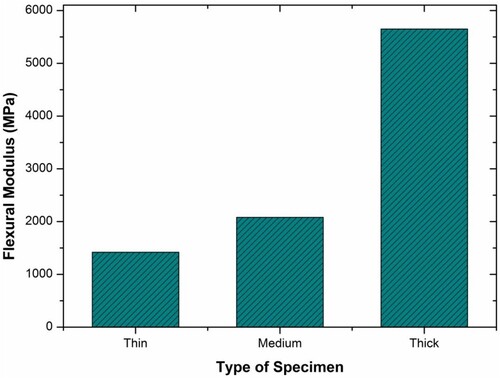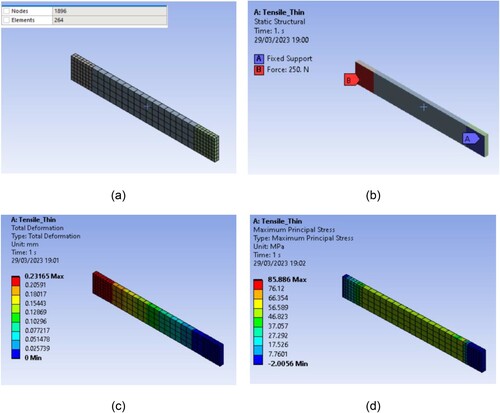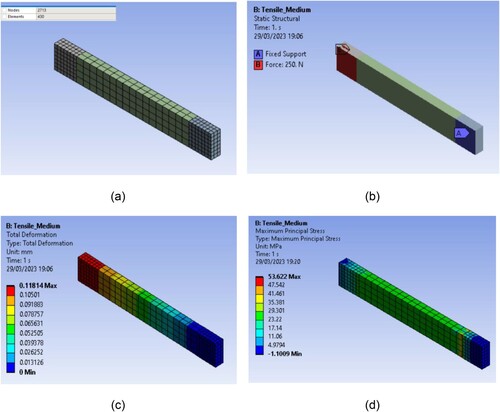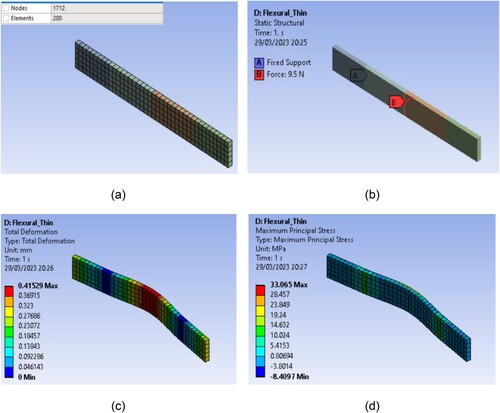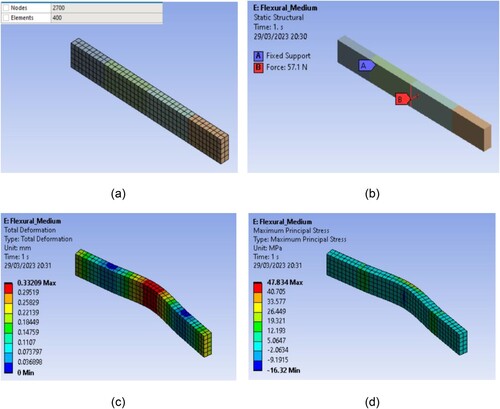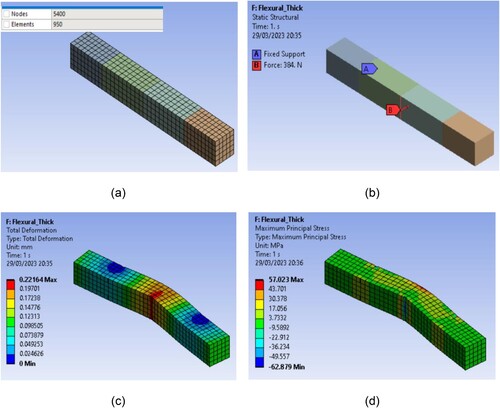 ?Mathematical formulae have been encoded as MathML and are displayed in this HTML version using MathJax in order to improve their display. Uncheck the box to turn MathJax off. This feature requires Javascript. Click on a formula to zoom.
?Mathematical formulae have been encoded as MathML and are displayed in this HTML version using MathJax in order to improve their display. Uncheck the box to turn MathJax off. This feature requires Javascript. Click on a formula to zoom.ABSTRACT
This study investigates the influence of material thickness on the mechanical properties, specifically flexural and tensile properties, of scapula bone specimens from Deccani breed sheep in India. A three-point bending test and a tensile test were conducted on samples with varying thicknesses (1, 2 and 5 mm), and the flexural strength, flexural modulus, ultimate load, tensile deformation and von Mises stress were measured. Thicker specimens exhibited higher flexural properties than thinner counterparts. Statistical analysis using one-way ANOVA confirmed that material thickness significantly impacted the flexural and tensile properties of the samples. Additionally, a simulation analysis was performed using ANSYS Workbench to validate the experimental results and provide insights into the tensile and flexural behaviour of the specimens. The findings suggest that thicker samples are better equipped to handle bending stresses and tensile loads and are more suitable for applications requiring resistance to bending loads, stiffness, load-bearing capacity and tensile strength.
1. Introduction
Currently, the world is focusing on sustainable development goals (SDGs) out of which this study focuses on SDG 12, i.e. responsible consumption and production. As Sheep have many body parts (namely horn, scapula bone and hoof) once taken out from the slaughterhouse will be thrown on earth as waste material. Bone is a living organ that is both intricate and dynamic. The bones in all the vertebrates meet a diverse set of functional demands, not all of which are mechanical. The most proximal bone of the sheep’s forelimb is the scapula. The scapula is located on the lateral wall of the thorax's cranial portion. It is a predominant bone for the relative motion of the forelimb. To adapt to the form of the thoracic wall, it is slightly curved and sloped laterally. It has a triangle outline, with a longer vertebral border and a narrower neck. The scapular spine is less tuberous. There are many studies to replace the scapula bone in sheep with various novel materials such as polylacrocaptone tricalcium phosphate (Spalthoff et al. Citation2019), polylactic acid and thermoplastic polyurethane (Kurt et al. Citation2022) and polyether ether ketone(PEEK) (Katsifis et al. Citation2023) as osseo-integration either directly with scaffold via 3D printing or plasma immersion ion implantation (PIII) imparts osteo-adhesion on 3D printed PEEK (Kruse et al. Citation2022). In India, the sheep is considered to be a workshop animal killed in the slaughterhouse and its parts such as the scapula, hoof and horn are thrown as waste materials on earth. This has created a lot of biowaste in the environment which is unutilized. However, it has lot many potential features such as the material once cleansed for biomedical applications has biocompatibility, biodegradability, eco-environmental and economically viable solutions and can replace many of the prerequisites of today’s biomedical world. As the tuber scapula is attached to the glenoid cavity's rim, the inferior or glenoid extremity is longer. The subscapular fossa has a large rim. Scapula bone is one of the most critical and unutilized parts in animals to date, which is left over from the slaughterhouse. Some of the parts such as the scapula, horn and hoop are the left-over parts in a typical big sheep horn animal (Mysore et al. Citation2021). Sheep and goats are common animals liced from the slaughterhouse and to date there is no proper utilization of these in society. As per census 2017 in India, the big sheep horn of Deccani has more than 4 million population in three states (Mysore et al. Citation2021; Lin and Kang Citation2021). Today, hardly there are any works identified by authors on scapula bone usage in real-time applications. The objective is to determine the variations in the mechanical properties of tthe scapula and the mechanical anisotropy along both longitudinal and transverse directions (Luo et al. Citation2019). The work by Albert (Beckers et al. Citation1998) focused on the microvascular mandibular construction in dental implants using the iliac crest and scapula bone. The density of the bone and thickness of the cortical seem to be matching with the iliac crest and scapula. Another study focused on the biometrical analysis of the scapula of the Indian civet, leopard cat and fishing cat (Pathak et al. Citation2021). The literature says swimming and climbing species disclose wider scapula bone (Charles and Bechtol Citation1980). Biometric study reveals the nomenclatures of each individual part of the scapula with the comparison of leopard cat, fishing cat and Indian civet (Galvez-Lopez Citation2020). Three cases of scapula bone have been studied ipsilateral upper limb and lower limb (Stacy and Yousefzadeh Citation2000).
The objective of the current work includes a comparative biometrical analysis of the scapula of animals with different compositions and structures of bone tissue (fishing cat, leopard cat and small Indian civet). This article provides a review and practical guide to understanding and analysing the mechanical properties of scapula bone defined by stress–strain curve performed under a uniaxial tensile testing machine until failure. Tensile, flexural, impact and bio-chemical tests and the like have been accomplished to understand material properties at different cross-section areas of the scapula. The solution data are further analysed using statistical and simulation tools. A thorough understanding of bone strength and the data on mechanical behaviour under various physical loads is arrived.
The study of the mechanical properties of biological materials is crucial for understanding their structural and functional role in living organisms (Currey Citation2006; Fratzl and Weinkamer Citation2007). Bones, in particular, play an essential part in providing support, protection and mobility to the body. The scapula bone, commonly referred to as the shoulder blade, is a flat, triangular bone that connects the humerus (upper arm bone) to the clavicle (collarbone) (Bar-On et al. Citation2018). The entire bone structure is non-uniform. It plays a vital role in the movement and stability of the shoulder joint, making it an essential subject for investigation. This research article aims to explore the mechanical properties of scapula bones from different animal species, to gain insights into their adaptability, resilience and evolutionary implications.
Scapula bones are unique in their shape and function, often exhibiting species-specific morphologies that reflect the animals’ locomotive habits, biomechanical needs and environmental pressures (Bar-On et al. Citation2018; Blob and Biewener Citation2001). The mechanical properties of the scapula can influence an animal's overall skeletal system, affecting its ability to withstand loads, resist fractures and adapt to various activities (Reilly and Currey Citation2000). Previous studies have focused on the mechanical properties of long bones, such as the femur and tibia (Currey Citation2006; Reilly and Currey Citation2000), while scapula bones have received comparatively less attention. By investigating the mechanical properties of scapula bones, this study will contribute to the broader understanding of bone biomechanics, biomaterials and comparative anatomy.
In this research article, we will examine the mechanical properties of scapula bones from various animal species, including mammals, birds and reptiles. We will employ a combination of experimental techniques, such as tensile testing, compression testing and three-point bending tests, to measure the strength, stiffness and toughness of the bone samples (Turner and Burr Citation1993). Additionally, we will investigate the microstructure of the scapula bone, analysing its mineral composition, collagen orientation and trabecular structure using scanning electron microscopy (SEM) and X-ray diffraction (XRD) (Fratzl et al. Citation2004).
Through a comprehensive understanding of the mechanical properties of scapula bones in animals, we aim to provide valuable insights into the structure–function relationship, the evolutionary adaptation of bones to different biomechanical needs and potential applications in the fields of orthopaedics, prosthetics and bio-inspired material designs (Bar-On et al. Citation2018; Fratzl and Weinkamer Citation2007). The findings of this study will not only advance our knowledge of bone biomechanics but also contribute to the development of innovative solutions for human health and well-being. illustrates the various kinds of animals having scapula bone with composition for a comparative study analysis.
Table 1. Composition of scapula bone available on earth with various animals.
2. Materials and methods
2.1. Materials
The focus of the study was on leftover parts from the slaughterhouse resulting in three of the main constituents in sheep. They are horn, scapula bone and hoof. However horn-related work has already been published (Mysore et al. Citation2021), whereas scapula bone and hoof are in the process of investigation for the feasibility study out of which scapula bone has been considered in this current work, as shown in , the Scapula bones of 1-year-old Deccani breed sheep (Karnataka sheep; Ovis Canadensis) were taken within 24 h of slaughter from a local butcher (Used for food purposes; Hubballi Taluq, Dharwad District, Karnataka, India). Before the specimens were extracted, the scapula bones were kept cool in a controlled atmosphere. The slicing strategy for obtaining the maximum number of coupons is depicted in and .
2.2. Methodology
In the form of methodology, a road map for the complete research project is framed. The details are depicted in with the process map. The project began with the extraction of a characteristic breed, ‘Deccani’, from a slaughterhouse. Each bone was chopped under certain ideal settings to get the most coupons from it. The specimens were removed following the ASTM standard and filed to produce the exact form and size shown in .
illustrates the mechanical and physical properties of scapula bone from various literature sources. These values are extracted as quoted in the predecessor work. The variation in terms of values might be because of many reasons to name a few the geographical indication and every species will have variation in its material properties as it evolved over some time based on the gene, climatic and local adoptive conditions.
Table 2. Mechanical and physical properties of scapula bone in various available sources.
3. Experimental tests
The current work is based on a thorough examination of the tensile and flexural properties of the scapula bone. All specimens are removed from the bone and scraped with 120-grit sandpaper. Five samples were created for each condition of specimen thickness, as shown in . The thin specimen is 1 mm thick, while the medium and thick specimens are 2 mm and 5 mm thick, respectively. The ASTM standard requires the flat specimens for result extraction and it is mandatory to have coupons of flat and longitudinal for the testing. The samples were tested in a dry (ambient) environment.
| a. | Tensile test: | ||||
Tensile tests were performed on a total of 15 samples. Five of them, in particular, are in thin, medium and thick condition. Tensile testing was carried out using Micro-universal testing equipment outfitted with 10KN load cells. The miniature specimens were created in accordance with ASTM D-3039 (Carlson and Judex Citation2007). To prevent sliding, the two ends of each sample were covered with a 100-grit sandpaper. On one end of the gripper, a uni-axial load is scoped. The gauge length was set at 25 mm, and the crosshead speed was set at 2 mm/min.
| b. | Flexural test: | ||||
Flexural strength testing determines the bending strength of a specific specimen. The coupons were sliced into rectangular prisms in accordance with ASTM D790–07 (ASTM International Citation2007; Yeni and Brown Citation1998). The coupon test for a 10-tonne capacity was performed using a Micro Universal Testing Machine (UTM) manufactured by Tinius Olsen in India (Bar-On et al. Citation2018). To create three sets of samples, fifteen coupons were etched, five for each thickness condition.
4. Results and discussion
4.1. Tensile strength test
Tensile strength tests were performed on three examples, and the results are shown in .
The tensile yield strength measured for the thin section of scapula bone is 81.3 MPa, which is more than that of High-Density Polyethylene, ABS, Polypropylene and comparable Poly-methyl-methacrylate (PMMA) and higher than that of other fibre-reinforced polymer composites (Yeni and Fyhrie Citation2001). The thin section is in a pristine form comprising calcium and hydroxyapatite which is strong in terms of tensile behaviour but in the case of the medium and thick sections in between bone there will be a soft tissue which does not provide a sufficient amount of strength during tensile strength test. .
illustrates the mechanical properties with thin and thick conditions. The yield strength of a thin specimen is 24.55% higher than that of a medium specimen and 87.72% higher than that of a thick specimen. Young's modulus for thin is 23.84% and 83.11% greater than for the other two situations. Failure strain is 36.18% higher in the medium condition and 63% higher in the thin and thick situations, respectively. Medium-condition specimens absorb 23.57% more energy and bend plastically without shattering than thick- and thick-condition specimens, respectively. Finally, distortion in the medium condition specimen is more than in other peers. However, we find that the yield strength of thin condition is 27.43% higher than the yield strength of dry longitudinal condition of large sheep horn (Mysore et al. Citation2021). Toughness for medium-conditioned specimens is 81% more than toughness for moist longitudinal conditions (Mysore et al. Citation2021) ().
Table 3. Material properties of scapula bone with varied thickness.
The data presented in the table show the mechanical properties of materials with varying thicknesses (1, 2 and 5 mm). The properties include Young's Modulus, Yield Strength, Ultimate Strength, Failure Strain and Toughness. A statistical analysis of these properties can provide insights into the behaviour and performance of these materials under different conditions.
Upon examining the mean values, there is a significant decrease in Young's Modulus, Yield Strength and Ultimate Strength as the material thickness increases. This trend may be attributed to the potential changes in material microstructure, porosity or overall structural integrity as the thickness increases. The thinner samples (1 and 2 mm) appear to have higher stiffness and strength compared to the thick (5 mm) sample, making them potentially better suited for applications requiring high load-bearing capacity and resistance to deformation.
The Failure Strain, which represents the material's ability to deform before failure, shows an interesting trend. The medium-thickness sample (2 mm) exhibits the highest failure strain among the three samples, suggesting that it may possess a better balance between stiffness and ductility compared to the thin (1 mm) and thick (5 mm) samples. This property could be advantageous for applications where energy absorption and resistance to fracture are crucial, such as in impact or dynamic loading situations.
The toughness values also show a noticeable trend, with the medium-thickness sample (2 mm) exhibiting the highest toughness, followed by the thin (1 mm) and thick (5 mm) samples. The higher toughness value for the medium-thickness sample indicates its potential ability to absorb more energy before failure, making it more suitable for applications where impact resistance and energy absorption are critical factors.
However, the coefficients of variation for these properties are relatively high, ranging from 33.25% to 52.97%. This suggests that there may be significant variability in the material properties across the samples, which could be attributed to factors such as inconsistencies in material processing, variations in microstructure or differences in the testing methodologies. It is essential to consider these variations when interpreting the results and making conclusions about the overall material behaviour.
However, from theabove table, it is quite clear that substantial results are achieved for thin- and medium-condition specimens. To confirm the importance of thickness on mechanical characteristics, a one-way ANOVA analysis was performed on the findings shown in using the Statistics Kingdom two-way ANOVA calculator. The influence of specimen thickness on yield stress, Young's modulus, ultimate strength and failure strain was investigated independently using one-way ANOVA. In , DF denotes the degree of freedom; SS denotes the sum of squares and MS is the mean square. Furthermore, the F-value and P-value are critical parameters to determine if thickness has a substantial effect on mechanical characteristics; we accept or reject the Null hypothesis depending on the values of F and P.
Table 4. One-way ANOVA results on the tensile properties of Deccani sheep scapula bone.
If the F-value tabulated in and is greater than the F-value determined using the F-table, the null hypothesis is rejected. Secondly, the P-value is used to decide the validity of the null hypothesis. If the P-value is less than the level of significance, i.e. P < 0.05, it can be said that thickness has a significant effect on mechanical property. For instance, here we will study the effect of thickness on yield strength, after executing one-way ANOVA since p-value <0.05, hence null hypothesis is rejected. The difference between the averages of some groups is big enough to be statistically significant.
From , it is concluded that significance of significance of thickness does exist on the mechanical properties of the scapula bone of Deccani breed sheep.
In conclusion, the provided data and statistical analysis suggest that material thickness has a substantial impact on the mechanical properties, with thinner samples generally exhibiting higher stiffness and strength, and medium-thickness samples demonstrating improved ductility and toughness. Further investigation, including more samples and additional property measurements, is required to obtain a comprehensive understanding of the relationship between material thickness and mechanical performance, as well as to identify the underlying factors responsible for these trends.
4.2. Flexural strength test
For all three thickness circumstances, a three-point bend test was performed on a scapula bone specimen. and indicate the variation of flexural characteristics with regard to scapula bone thickness. Flexural characteristics for thick specimens are determined to be the highest when compared to other peers. Flexural strength for thick specimens is 36.97%, 10% higher than for thin and medium conditioned specimens, but 29.76% lower than for huge sheep horns [our study]. Whereas the flexural modulus of a thick conditioned specimen is 74.85%, 63.71% higher than that of a thin or medium specimen and 55% higher than that of a huge sheep horn of the same breed [our work]. As a result, thick-conditioned specimens may withstand bending loads better than their contemporaries. However, the thin section is in a pristine form comprising calcium and hydroxyapatite which is strong in terms of tensile behaviour but weak in flexural strength test resulting in early failure compared to medium and thick sections. This provides additional bending strength to the member which will behave in ductile failure rather than mere brittle failure for thin sections ().
Upon examining the data, it can be observed that the Flexural Strength, which represents the material's ability to resist failure under bending loads, increases as the material thickness increases. The thick sample (5 mm) has the highest Flexural Strength, followed by the medium (2 mm) and thin (1 mm) samples. This trend suggests that thicker samples are better equipped to handle bending stresses and may be more suitable for applications where bending loads are expected.
Figure 9. Maximum flexural strength for thin, medium and thick condition specimens by three-point bend test.
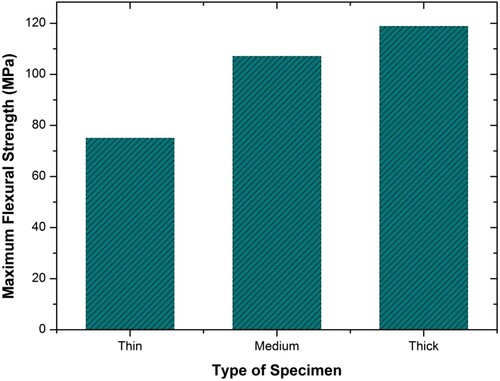
Table 5. Flexural properties of Deccani sheep scapula bone.
The Flexural Modulus, which indicates the material's stiffness under bending conditions, also increases with material thickness. The thick sample (5 mm) exhibits a considerably higher Flexural Modulus compared to the medium (2 mm) and thin (1 mm) samples. This finding implies that the thick sample is much stiffer and less prone to deformation under bending loads, making it a suitable candidate for applications requiring high stiffness and resistance to bending deformation.
The Ultimate Load, which represents the maximum load a material can withstand before failure, shows a significant increase as the material thickness increases. The thick sample (5 mm) demonstrates a substantially higher Ultimate Load compared to the medium (2 mm) and thin (1 mm) samples. This result is consistent with the trends observed for Flexural Strength and Flexural Modulus, further reinforcing the notion that thicker samples are better equipped to handle higher bending loads before failing.
Calculation: The steps to calculate Bending Strength are as mentioned below.
Formula
where P = Ultimate load (N); L = Gauge length (mm); b = Width of Specimen(mm); d = Depth or thickness of Specimen (mm).
Specimen dimension
where Total length = 40 mm; Gauge length(L) = 25 mm; Width of specimen (b) = 5 mm; Thickness of specimen (d) = 1 mm.
Sample calculation
Flexural modulus
shows flexural modulus for thin, medium and thick condition specimens by three-point bend test and illustrates the maximum flexural strength for thin, medium and thick condition specimens by the three-point bend test.
The one-way ANOVA test results for flexural characteristics of deccani sheep scapula bone are shown in . When all of the F-values are compared to the critical values from the table, it is obvious that thickness has a substantial influence on the flexural modulus and flexural strength of the Scapula bone.
Table 6. One-way ANOVA results on the flexural properties of scapula bone of Deccani breed sheep.
The data presented in the table suggest that material thickness has a considerable impact on the flexural properties of the samples. Thicker samples generally exhibit higher Flexural Strength, Flexural Modulus and Ultimate Load, making them more suitable for applications where resistance to bending loads, stiffness and load-bearing capacity is a critical factor. However, it is essential to consider the specific requirements of an application and weigh the benefits of higher flexural properties against other factors, such as weight, manufacturing complexity and cost, before making any final material selection decisions.
5. Simulation
The work is incomplete and costlier if we do not follow the simulation analysis. It is a simulation that can make a lot of difference in terms of optimal design and experimental reduction. The entire analysis involves ANSYS Workbench as a tool for realizing the comparative study of experimental and simulation results.
5.1. Tensile strength
| a. | Thickness 1 mm | ||||
The typical model was developed with a dimension of as per ASTM 3039M and using a design modeller the micro-gripping regions split for load and boundary condition application. The element type used in this model is SOLID186 with second-order elements for 20 nodes. The entire model meshed with 1896 nodes and 264 elements keeping in mind the stress concentration regions at the microgripper region. The details are depicted in for the 1 mm thickness tensile strength model.
| b. | Thickness 2 mm | ||||
The entire assembly is subjected to a load of 250N at one end and constrained at the other end with all the degrees of freedom. The results, shown in , discuss total deformation as 0.118 mm and 53.62 MPa. In comparison to 1 mm thickness 0.231 mm and 85.88 MPa show high stress for lower thickness values.
| c. | Thickness 5 mm | ||||
The results shown in depict total deformation as 0.052 mm and 31.08 MPa. In comparison to 1 mm thickness 0.231 mm and 85.88 MPa show high stress for lower thickness values.
5.2. Flexural strength
| a. | Thickness 1 mm | ||||
The typical model developed with a dimension of as per ASTM D7264M and using design modeller the simply supported rollers considered at the base and on top of it a roller will enforce a load as per description as micro-gripping regions split for load and boundary condition application. The element type used in this model is SOLID186 with second-order elements for 20 nodes. The entire model is meshed with 1712 nodes and 200 elements keeping in mind the stress concentration regions at the microgripper region. The details are depicted in for the 1 mm thickness flexural strength model. discusses the 2 mm thick model, 2700 nodes and 400 elements and finally 5 mm thick model as illustrated in with 5400 nodes and 950 elements.
shows the details about the comparative study between the flexural strength and tensile strength for the thickness of scapula bone from 1 mm to 5 mm specimen.
Table 7. Comparative data with tensile and flexural strength.
6. Conclusion
This study demonstrates a clear relationship between the thickness of scapula bone specimens from Deccani breed sheep and their mechanical properties, specifically flexural and tensile properties. The results from both the experimental and simulation analyses indicate that as the material thickness increases, the flexural strength, flexural modulus, ultimate load, tensile deformation and von Mises stress all exhibit a corresponding increase. Statistical analysis using one-way ANOVA further confirmed the significant impact of material thickness on these properties.
Thin samples have the highest Young's modulus (109.9 MPa), followed by medium samples (83.70 MPa) and the lowest value for thick samples (18.56 MPa). This indicates that thin samples are the stiffest, while thick samples are the most compliant.
Both yield strength and ultimate strength show a similar trend, with the highest values in thin samples (81.3 and 84.7 MPa), followed by medium samples (61.34 and 61.68 MPa) and the lowest in thick samples (9.98 and 11.2 MPa). This implies that thin samples can withstand higher stresses before undergoing plastic deformation or failure.
Medium samples have the highest failure strain (3.04%), followed by thin samples (1.9375%), and the lowest in thick samples (1.125%). This result indicates that medium samples can undergo more deformation before failure compared to thin and thick samples.
Medium samples exhibit the highest toughness (139.7925 MJ/m^3), followed by thin samples (106.62625 MJ/m^3) and the lowest in thick samples (11.4925 MJ/m^3). This suggests that medium samples can absorb more energy before failure, making them more resistant to fractures.
Thick samples have the highest flexural strength (118.8 MPa), followed by medium samples (107.06 MPa) and the lowest in thin samples (75 MPa). This implies that thick samples can withstand higher bending stresses before failure.
Thick samples demonstrate the highest flexural modulus (5650.684 MPa), followed by medium samples (2080.66 MPa) and the lowest in thin samples (1420.45 MPa). This indicates that thick samples are the stiffest under bending loads.
Thick samples have the highest ultimate load (0.384 kN), followed by medium samples (0.0571 kN) and the lowest in thin samples (0.0095 kN). This result suggests that thick samples can support more weight before failure.
In summary, the mechanical properties of scapula bones vary with thickness. Thin samples generally have higher tensile properties, while thick samples exhibit superior flexural properties. Medium samples exhibit the highest failure strain and toughness, indicating their ability to withstand more deformation and energy absorption before failure. These comparisons are essential when designing implants or prosthetics to ensure appropriate mechanical properties and functionality.
Thicker specimens, therefore, show greater resistance to bending loads, higher stiffness, enhanced load-bearing capacity and improved tensile strength. It depends on the application whether a brittle fracture is the design criteria or ductile fracture is the design criteria for the end applications. According to these aspects, a suitable thickness material may be considered for use. This information is valuable for material selection and design in various applications where these properties are critical factors. However, it is essential to consider the specific requirements of each application and evaluate the benefits of increased mechanical properties against other factors such as weight, manufacturing complexity and cost.
Future research could focus on optimizing the material thickness for specific applications, investigating the influence of other factors such as material composition and exploring alternative materials that exhibit similar or improved mechanical properties. Overall, this study contributes essential knowledge to the field of material science and engineering, helping to inform material selection and design processes in applications where flexural and tensile properties are vital considerations.
Disclosure statement
No potential conflict of interest was reported by the author(s).
Additional information
Funding
References
- Alexander RM, Pond CM. 1992. Locomotion and the design of limb bones. J Zool. 226(4):515–524.
- ASTM International. ASTM D790-07 standard test methods for flexural properties of unreinforced and reinforced plastics and electrical insulating materials. 2007.
- Bar-On B, Weisse B, Fischer MS. 2018. The shoulder girdle of the European roe deer and its biomechanical properties. Anat Rec. 301(3):518–527. doi:10.1002/ar.23719.
- Beckers A, Schenck C, Klesper B, Koebke J. 1998. Comparative densitometric study of iliac crest and scapula bone in relation to osseous integrated dental implants in microvascular mandibular reconstruction. J Cranio-Maxillofacial Surg. 26:75–83. doi:10.1016/S1010-5182(98)80043-7.
- Blob RW, Biewener AA. 2001. Mechanics of limb bone loading during terrestrial locomotion in the green iguana (Iguana iguana) and American alligator (Alligator mississippiensis). J Exp Biol. 204(6):1099–1122. doi:10.1242/jeb.204.6.1099.
- Boskey AL, Posner AS. 1984. Bone structure, composition, and mineralization. Orthop Clin N Am. 15(3):597–612. doi:10.1016/S0030-5898(20)31258-X.
- Carlson KJ, Judex S. 2007. Functional morphology of the North American beaver (Castor canadensis): implications for skeletal system design. J Morphol. 268(4):281–290.
- Charles O, Bechtol MD. 1980. Biomechanics of the shoulder. Clin Orthop Relat Res. 146:37–41.
- Currey JD. 2006. Bones: structure and mechanics. Princeton: Princeton University Press.
- Fratzl P, Gupta HS, Paschalis EP, Roschger P. 2004. Structure and mechanical quality of the collagen–mineral nano-composite in bone. J Mater Chem. 14(14):2115–2123. doi:10.1039/B402005G.
- Fratzl P, Weinkamer R. 2007. Nature's hierarchical materials. Prog Mater Sci. 52(8):1263–1334. doi:10.1016/j.pmatsci.2007.06.001.
- Galvez-Lopez E. 2020. Quantifying morphological adaptations using direct measurements: the carnivoran appendicular skeleton as a case study. Anat Rec. 304:1–27. doi:10.1002/ar.24453.
- Katsifis G, Kruse H, Lewin W, Al Maruf A, Clark JR, McKenzie DR, Suchowerska N. 2023. Micro-CT analysis of implanted poly-ether-ether-ketone scaffolds: plasma immersion ion implantation increases osteoconduction. Adv Eng Mater. 25:2201297. doi:10.1002/adem.202201297.
- Kruse HV, Lewin WT, Suchowerska N, S D, Al Maruf A, Cheng K, Clark JR, McKenzie DR. 2022. Plasma immersion ion-implanted 3D-printed PEEK bone implants: in vivo sheep study shows strong osseointegration. Plasma Processes Polym. 19(7):2100244. doi:10.1002/ppap.202100244.
- Kurt S, Selviler-Sizer S, Onuk B, Kabak M. 2022. Comparison of sheep scapula models created with polylactic acid and thermoplastic polyurethane filaments by three-dimensional modelling. Anat Histol Embryol. 51:244–249. doi:10.1111/ahe.12784.
- Lin C-Y, Kang J-H. 2021. Mechanical properties of compact bone defined by the stress-strain curve measured using uniaxial tensile test: a concise review and practical guide. Materials (Basel). 14(15):4224.
- Luo C, Liao J, Zhenglin Zhu X, Lin X, Huang W. 2019. Analysis of mechanical properties and mechanical anisotropy in canine bone tissues of various ages. Bio Med Res Int. 2019:3503152.
- Martiniaková M, Grosskopf B, Omelka R, Vondráková M, Bauerová M. 2006. Differences among species in compact bone tissue microstructure of mammalian skeleton: use of a discriminant function analysis for species identification. J Forensic Sci. 51(6):1235–1239. doi:10.1111/j.1556-4029.2006.00260.x.
- Mysore THM, Patil AY, Raju GU, Banapurmath NR, Bhovi PM, Afzal A, Alamri S, Saleel CA. 2021. Investigation of mechanical and physical properties of big sheep horn as an alternative biomaterial for structural applications. Materials (Basel). 14:4039. doi:10.3390/ma14144039.
- Pathak SK, Archana Mahapatra A, Pawade AM. 2021. Biometrical analysis of scapula bone of fishing cat, leopard cat and small Indian civet. Appl Biol Res. 23(1):110–111. DOI:10.5958/0974-4517.2021.00015.X.
- Price C, Herman BC, Lufkin T, Goldman HM, Jepsen KJ. 2005. Genetic variation in bone growth patterns defines adult mouse bone fragility. J Bone Miner Res. 20(11):1983–1991. doi:10.1359/JBMR.050707.
- Reilly DT, Burstein AH. 1975. The elastic and ultimate properties of compact bone tissue. J Biomech. 8(6):393–405. doi:10.1016/0021-9290(75)90075-5.
- Reilly DT, Currey JD. 2000. The effects of damage and microcracking on the impact strength of bone. J Biomech. 33(3):337–343. doi:10.1016/S0021-9290(99)00167-0.
- Shaw JM, Stock JT. 2009. The influence of body proportions on thermoregulation: a comparison of three human groups. Am J Phys Anthropol. 140(2):199–209. doi:10.1002/ajpa.21163.
- Skedros JG, Dayton MR, Sybrowsky CL, Bloebaum RD, Bachus KN. 2003a. The influence of collagen fiber orientation and other histocompositional characteristics on the mechanical properties of equine cortical bone. J Exp Biol. 206(17):2997–3008.
- Skedros JG, Dayton MR, Sybrowsky CL, Bloebaum RD, Bachus KN. 2003b. The influence of collagen fiber orientation and other histocompositional characteristics on the mechanical properties of equine cortical bone. J Exp Biol. 206(20):537–3489.
- Spalthoff S, Zimmerer R, Dittmann J, Korn P, Gellrich N-C, Jehn P. 2019. Scapula pre-augmentation in sheep with polycaprolactone tricalcium phosphate scaffolds. J Stomatol Oral Maxillofac Surg. 120(2):116–121. doi:10.1016/j.jormas.2018.10.001.
- Stacy GS, Yousefzadeh DK. 2000. Scapular duplication. Pediatr Radiol. 30:412–414. doi:10.1007/s002470050774.
- Turner CH, Burr DB. 1993. Basic biomechanical measurements of bone: a tutorial. Bone. 14(4):595–608. doi:10.1016/8756-3282(93)90081-K.
- Yeni YN, Brown CU. 1998. Influence of bone composition and apparent density on fracture toughness of the human femur and tibia. Bone. 22(1):79–84. doi:10.1016/S8756-3282(97)00227-5.
- Yeni YN, Fyhrie DP. 2001. A rate-dependent microcrack-bridging model that can explain the strain rate dependency of cortical bone apparent yield strength. J Biomech. 34(11):1347–1357.

